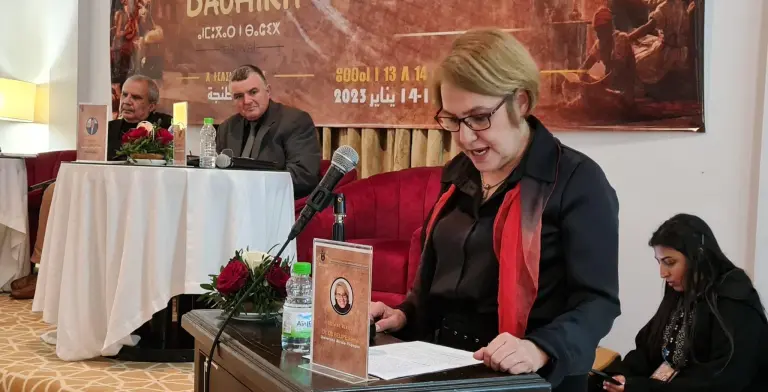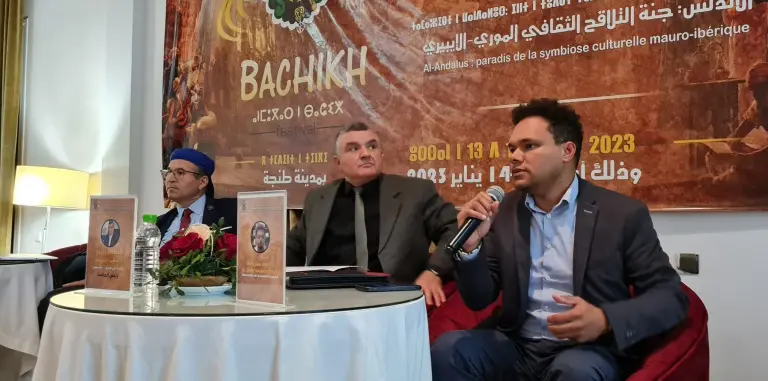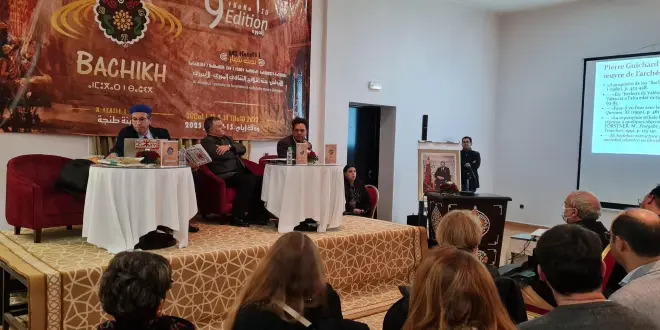Researchers and academics monitor the contribution of the Amazighs to building the civilization of Andalusia

Researchers and academics from Morocco, Spain and France monitored the manifestations of the influence of the Amazigh s who, over the course of 8 centuries, contributed to building the Andalusian civilization.
The organizers of the international scientific symposium “The Amazigh Contribution to Building the Civilization of Andalusia” organized by the “Sanhaja Amazigh Association of the Rif”, within the ninth session of the “Basheikh” Festival for the Amazigh New Year 2973, in Tangier, under the slogan “Andalusia: A Paradise of Moorish-Iberian Cultural Cross-pollination”, agreed on The contribution of the Amazighs to building the civilization of Andalusia, as “the political and historical momentum of the Amazighs left an undeniable cultural and social impact.”

Moroccan and foreign researchers and academics touched on the contribution of the Amazighs to the civilization of Andalusia through eight axes: the intellectual and cultural manifestations of the Amazighs in Andalusia, the Amazigh toponymy in Andalusia, the Amazigh urban exploits in Andalusia, the social and economic relations of Moroccans in Andalusia, as well as the political and military contributions.
Mohamed Hakki, a professor of social history at Sultan Moulay Suleiman University in Beni Mellal, stopped at the Berbers’ contribution to securing Andalusia and ensuring its continuity, noting that the Amazighs became, immediately after the conquest, an essential element in protecting Andalusia from Christian attacks from the north, “as they formed a barrier in the mountains Which is located in the north of Toledo”, “and they supported the caliphate in achieving its projects, whether it was in North Africa against the Fatimids, or against Christians in northern Europe, or even the internal revolutionaries who had to be eliminated to unify Andalusia.”

The researcher added that the Moroccan role shifted from a group operating under the command of the Andalusians to an official role led by the three main Moroccan states: the Almoravid Almohads and the Marinids, “they are the three countries that undertook the protection of Andalusia.”
Among the manifestations of the Amazighs’ contribution to the civilization of Andalusia, Hakki affirmed that the Amazighs transferred to Andalusia everything related to agricultural and agricultural works and crafts, in addition to Amazigh art “which won the admiration of Andalusians, especially in the era of the caliphate,” in addition to their presence in the administration with all its elements, in the Andalusian army, and in the cultural aspect. “They achieved a number of achievements in various sciences, and they were proactive in some fields, such as spreading the Maliki school of thought in Andalusia.”

While the intervention of Professor Moulay El Hassan Maghar, from the University of Moulay Ismail in Meknes, centered on a group of points of a systematic and documentary nature, pointing to the difficulty of talking about economic and social history, which in most of its issues was exposed to the political and military aspects, stressing the need to return to the buried and involuntary sources in order to diversify The source body to find out the nature of the social and economic relations that were organized among the Moroccans in Andalusia.
And he explained in an intervention entitled “The Social and Economic Relations of Moroccans in Andalusia,” that these relations ranged between marriage and divorce and the importance of the tribe’s presence as a social and political organization in Andalusian society, which was based largely around the Amazigh elements, then the Arabs and other ethnicities that existed in Andalusian society. The importance of economic activity, which was based on what Andalusia included in terms of natural qualifications and economic bounties of iron and fertile soil, formed a ground for the economic boom that flourished among these components that gathered to weave Andalusian society.

For his part, the Spanish researcher Bilal Sarr, a professor at the Department of Medieval History at the University of Granada, Spain, spoke about the Amazigh presence in Andalusia throughout the period from the tenth to the fourteenth century AD, noting that a number of Spanish cities, regions and terrain bear names of Amazigh origin.
Sar confirmed that the indicators and effects of the Amazigh civilization in Andalusia are strongly present, evoking the influence of the Amazigh tribes in the “Spanish utoponemia,” stressing the need to intensify research efforts in utoponemia and Spanish heritage.
In turn, the head of the Amazigh World Assembly, Rachid Al-Rakha, confirmed that the Amazigh contributions to building the Andalusian-Islamic civilization extended for more than eight centuries, “however, they were not recognized in the Moroccan and Spanish historical writings.”

In his intervention, entitled “How eight centuries of the history of the Amazighs in Andalusia were confiscated,” he emphasized that what the Amazighs achieved in various fields was attributed to other peoples and ethnicities for fraud.
Al-Rakha criticized the Moroccan and Spanish educational curricula, which missed the Amazigh contributions to building the Andalusian civilization, and its continuous endeavor to obliterate and falsify historical facts, evoking the falsification of identities that the Moroccan national team was subjected to after it achieved it during the 2022 World Cup, and the successive attempts to attribute this Amazigh achievement to the Arabs.
Al-Rakha added that Spanish historians avoid discussing Amazigh, pointing out that most Spanish universities have centers for Arabic-Semitic studies, with the exception of Cadiz University, which is the only one that has a center for Amazigh studies. “They also contributed to the falsification of the history of the Moroccan Amazighs and other North African peoples in Andalusia, by replacing the word “Los Moros” with the word “Arabs” due to the racism that this word carried.

On the other hand, the Rakhah confirmed that there was a great interest in the Jewish element, because they left a written trace in the Hebrew language in all manifestations of their lives there, while the Amazighs used to write everything in Arabic, which led to its attribution to the Arabs.
The symposium included an intervention by Dr. De Felipe Elena from the Spanish University of Acala, on the topic “The Amazighs in Andalusia and the Amazighs of Andalusia, Two Models of Contribution”, and an intervention by Dr. Muhanad Talmatin from the Spanish University of Cadiz, entitled “January and Cultural Mixing in Andalusia”, while Dr. Abdullah Bonfour spoke about Enalco French, on the subject of “The Amazighs in Andalusia: On the Origins of the Barghawati and the Rakrakis.”
Source: websites

